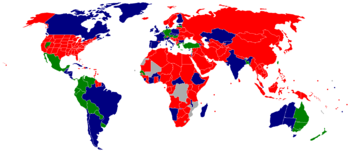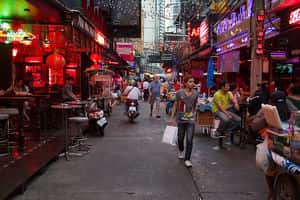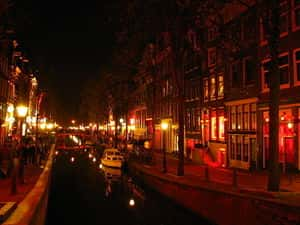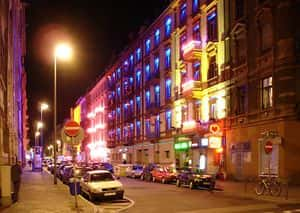Red-light district
A red-light district is a part of an urban area where there is a concentration of prostitution and sex-oriented businesses, such as sex shops, strip clubs, adult theaters, etc. The term originates from the red lights that were used as signs of brothels.There are areas in many big cities around the world which have acquired an international reputation as red-light districts. Some red-light districts have acquired a touristic interest beyond sex tourism, and can be perceived as places of artistic, historic or cultural interest, whether or not they still serve the sex trade.
Watch Live Sex Shows anywhere in the world!


Check out also:
Origins of term
According to the Oxford English Dictionary, the earliest known appearance of the term "red light district" in print is in an 1894 article from The Sandusky Register, a newspaper in Sandusky, Ohio. Author Paul Wellman suggests that this and other terms associated with the American Old West originated in Dodge City, Kansas, home to a well-known prostitution district during the 19th century, which included the Red Light House saloon. This has not been proven, but the Dodge City use was likely responsible for the term becoming pervasive. A widespread folk etymology claims that early railroad workers took red lanterns with them when they visited brothels so that their crew could find them in the event of an emergency. However, folklorist Barbara Mikkelson regards this as unfounded.
One of the many terms used for a red-light district in Japanese is nihongo akasen 赤線, literally meaning "red-line." (This has independent origins from redlining|the same term in English.) Japanese police drew a red line on maps to indicate the boundaries of legal red-light districts. In Japanese, the term nihongo aosen 青線, literally meaning "blue-line," also exists, indicating a non-legal district.
In the United States during the 19th and early 20th centuries, the term sporting district became popular for legal red-light districts. Municipal governments typically defined such districts explicitly to contain and regulate prostitution.
Apocryphal information exists indicating that the red light was used inside the bedchambers of brothels to obscure and conceal from patrons the red blemishes of various venereal diseases upon the skin of the prostitutes. The red light seen from outside through the curtains became known as a sign of the activities within.
Legal issues
Most mid- and big-size cities around the world have red-light districts, although the legality of the activities that occur in these areas, the degree of openness with which they are conducted, as well as the views of the general public and the authorities on these districts differ widely around the world.
Some red-light districts (such as De Wallen, Netherlands, or Reeperbahn, Germany) are places which are officially designated by authorities for legal and regulated prostitution. Often these red-light districts were formed by authorities to help regulate prostitution and other related activities, such that they were confined to a single area. With the confining of such industries to a single area, such districts became a destination for originally sailors but also tourists. Red light districts such as De Wallen, Amsterdam and Reeperbahn, Germany both bring a tons of tourism to these cities.
Other red-light districts, such as those from Thailand, and most parts of Asia, are areas which are unofficially monitored by the authorities: in spite of the illegality of prostitution in these places, the practice is tolerated and controlled by officials, and little is done to reduce or eliminate it. These type of red light districts are often great for the economy since they bring a lot of tourism which brings money to the street food vendors, hotels, local families etc.
See Also
- Asia, Oceania, Europe, Africa, North America, South America
- Prostitution, Street prostitution, Global prostitution prices
- Sex topics & Phrasebooks, Sex worker, Prostitute types
- List of red-light districts all over the world
- Brothel, Escort agency, Call girl, Erotic massage, Strip club
- Sex tourism, Sex industry, Countries with most prostitutes
- Sex vocabulary & Abbreviations, Humorous sexual terms
- Gay, Lesbian, Gay and lesbian travel, Bisexuality, Ladyboy
- Age of consent, Stay safe, Scams, Safe sex, STD, HIV/AIDS




